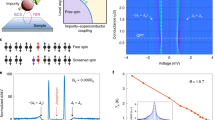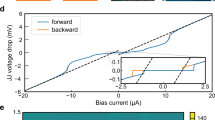Abstract
A charge current can flow between two superconductors separated by a thin barrier. This phenomenon is the Josephson effect, which enables a current to tunnel at zero voltage1, typically with no phase shift between the superconductors in the lowest-energy state. Recently, Josephson junctions with ground-state phase shifts of π, proposed by theory three decades ago2, have been demonstrated3,4,5. In superconducting loops, π-junctions cause spontaneous circulation of persistent currents in zero magnetic field2, in analogy to spin-1/2 systems6. Here we use a scanning superconducting quantum interference device microscope7 to image the spontaneous zero-field currents in superconducting networks of temperature-controlled π-junctions with weakly ferromagnetic barriers3. We find an onset of spontaneous supercurrents at the 0–π transition temperature of the junctions, Tπ≈3 K. We image the currents in non-uniformly frustrated arrays consisting of cells with even and odd numbers of π-junctions. Such arrays are attractive model systems for studying the exotic phases of the two-dimensional XY-model8,9 and achieving scalable adiabatic quantum computers10.
This is a preview of subscription content, access via your institution
Access options
Subscribe to this journal
Receive 12 print issues and online access
$259.00 per year
only $21.58 per issue
Buy this article
- Purchase on SpringerLink
- Instant access to full article PDF
Prices may be subject to local taxes which are calculated during checkout




Similar content being viewed by others
References
Josephson, B. D. Possible new effects in superconductive tunneling. Phys. Lett. 1, 251–253 (1962).
Bulaevskii, L. N., Kuzii, V. V. & Sobyanin, A. A. Superconducting system with weak coupling to a current in the ground state. JETP Lett. 25, 290–294 (1977).
Ryazanov, V. V. et al. Coupling of two superconductors through a ferromagnet: evidence for a π-junction. Phys. Rev. Lett. 86, 2427–2430 (2001).
Baselmans, J. J. A., Morpurgo, A. F., van Wees, B. & Klapwijk, T. M. Reversing the direction of supercurrent in a controllable Josephson junction. Nature 397, 43–45 (1999).
vam Dam, J. A., Nazarov, Y. V., Bakkers, E. P. A. M., De Franceschi, S. & Kouwenhoven, L. P. Supercurrent reversal in quantum dots. Nature 442, 667–670 (2006).
Della Rocca, M. L., Aprili, M., Kontos, T., Gomez, A. & Spathis, P. Ferromagnetic 0–π junctions as classical spins. Phys. Rev. Lett. 94, 197003 (2005).
Vu, L. N. & Van Harlingen, D. J. Design and implementation of a scanning SQUID microscope. IEEE Trans. Appl. Supercond. 3, 1918–1921 (1993).
Korshunov, S. E. Phase transitions in two-dimensional systems with continuous degeneracy. Phys.-Uspekhi 49, 225–262 (2006).
Leo, C. D. & Rotoli, G. Paramagnetic and diamagnetic states in two-dimensional Josephson-junction arrays. Phys. Rev. Lett. 89, 167001 (2002).
Ioffe, L. B., Geshkenbein, V. B., Feigelman, M. V., Fauchere, A. L. & Blatter, G. Environmentally decoupled sds-wave Josephson junctions for quantum computing. Nature 398, 679–681 (1999).
Fulde, P. & Ferrell, R. A. Superconductivity in a strong spin-exchange field. Phys. Rev. 135, A550–A563 (1964).
Larkin, A. I. & Ovchinnikov, Y. N. Inhomogeneous state of superconductors. Sov. Phys. JETP 20, 762–769 (1965).
de Jong, M. J. & Beenaker, C. W. J. Andreev reflection in ferromagnet–superconductor junctions. Phys. Rev. Lett. 74, 1657 (1995).
Buzdin, A. I. Proximity effects in superconductor–ferromagnet heterostructures. Rev. Mod. Phys. 77, 935–976 (2005).
Oboznov, V. A., Bolginov, V. V., Feofanov, A. K., Ryazanov, V. V. & Buzdin, A. I. Thickness dependence of the Josephson ground states of superconductor–ferromagnet–superconductor junctions. Phys. Rev. Lett. 96, 197003 (2006).
Yamashita, T., Tanikawa, K., Takahashi, S. & Maekawa, S. Superconducting π qubit with a ferromagnetic Josephson junction. Phys. Rev. Lett. 95, 097001 (2005).
Ustinov, A. V. & Kaplunenko, V. K. Rapid single-flux quantum logic using π-shifters. J. Appl. Phys. 94, 5405–5407 (2003).
Fominov, Y. V., Golubov, A. A. & Kupriyanov, M. Y. Decoherence due to nodal quasiparticles in d-wave qubits. JETP Lett. 77, 587–591 (2003).
Weides, M. et al. High quality ferromagnetic 0 and π Josephson tunnel junctions. Appl. Phys. Lett. 89, 122511 (2006).
Hilgenkamp, H. et al. Ordering and manipulation of the magnetic moments in large-scale superconducting π-loop arrays. Nature 442, 50–53 (2003).
Van Harlingen, D. J. Phase-sensitive tests of the symmetry of the pairing state in the high-temperature superconductors—Evidence for d x 2 − y 2 symmetry. Rev. Mod. Phys. 67, 515–535 (1995).
Frolov, S. M., Van Harlingen, D. J., Oboznov, V. A., Bolginov, V. V. & Ryazanov, V. V. Measurement of the current–phase relation of superconductor/ferromagnet/superconductor π Josephson junctions. Phys. Rev. B 70, 144505 (2004).
Ryazanov, V. V., Oboznov, V. A., Veretennikov, A. V. & Rusanov, A. Y. Intrinsically frustrated superconducting array of superconductor–ferromagnet–superconductor π junctions. Phys. Rev. B 65, 020501 (2001).
Frolov, S. M., Van Harlingen, D. J., Bolginov, V. V., Oboznov, V. A. & Ryazanov, V. V. Josephson interferometry and Shapiro step measurements of superconductor–ferromagnet–superconductor 0–π junctions. Phys. Rev. B 74, 020503 (2006).
Acknowledgements
Research on π-Josephson junctions was supported by the National Science Foundation grant EIA-01-21568, by the US Civilian Research and Development Foundation (CRDF) grant RUP1-2691-CG-05 and by the Russian Foundation for Basic Research. The SSM imaging was supported by the Department of Energy Office of Basic Energy Sciences (DOE-BES) grant DEFG02-91-ER45439 through the Frederick Seitz Materials Research Laboratory at the University of Illinois at Urbana-Champaign.
Measurements, simulations and analysis were carried out by the Urbana group; arrays were fabricated by the Chernogolovka group; d.c. SQUID detectors were fabricated by the Naples group.
Author information
Authors and Affiliations
Corresponding author
Rights and permissions
About this article
Cite this article
Frolov, S., Stoutimore, M., Crane, T. et al. Imaging spontaneous currents in superconducting arrays of π-junctions. Nature Phys 4, 32–36 (2008). https://doi.org/10.1038/nphys780
Received:
Accepted:
Published:
Issue date:
DOI: https://doi.org/10.1038/nphys780
This article is cited by
-
The Potential of the Josephson Energy
Journal of Superconductivity and Novel Magnetism (2021)
-
Implementation of superconductor/ferromagnet/ superconductor π-shifters in superconducting digital and quantum circuits
Nature Physics (2010)



